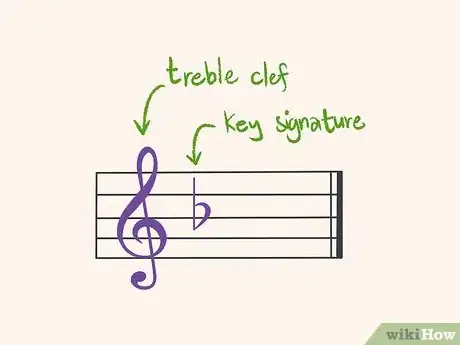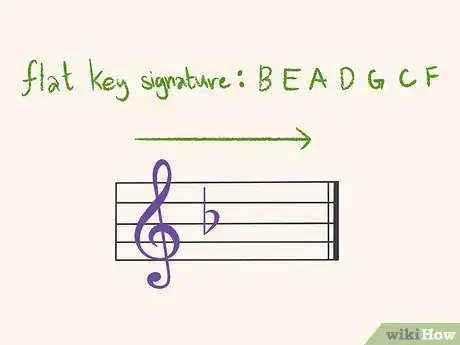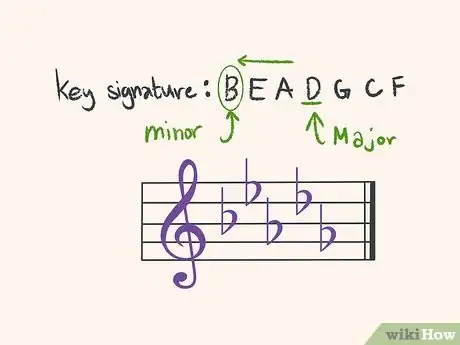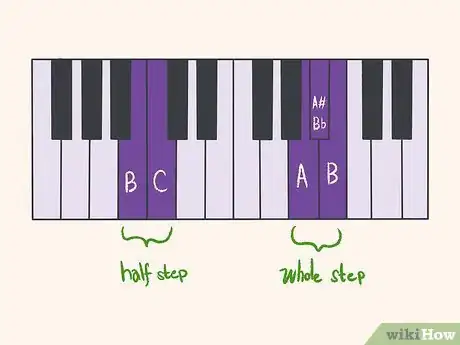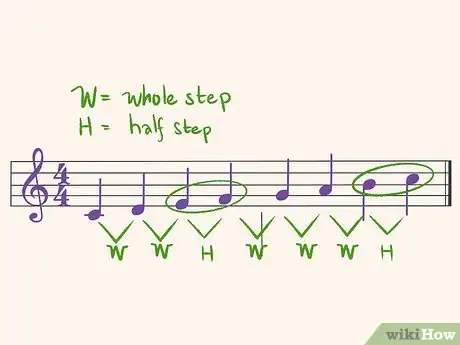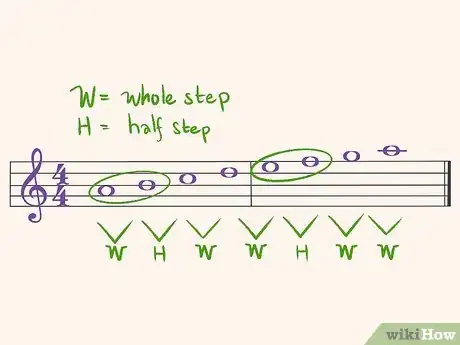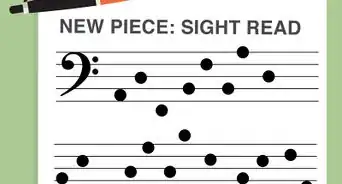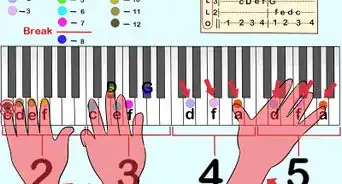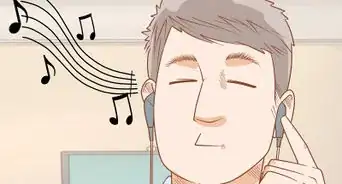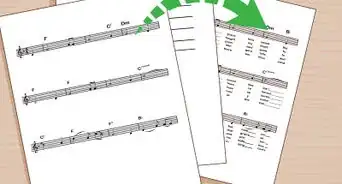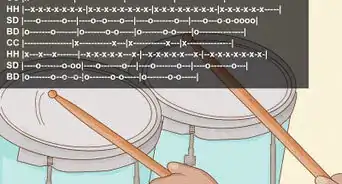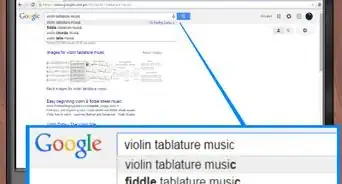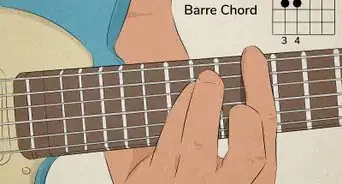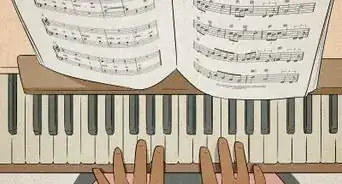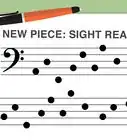This article was co-authored by wikiHow staff writer, Jennifer Mueller, JD. Jennifer Mueller is a wikiHow Content Creator. She specializes in reviewing, fact-checking, and evaluating wikiHow's content to ensure thoroughness and accuracy. Jennifer holds a JD from Indiana University Maurer School of Law in 2006.
There are 7 references cited in this article, which can be found at the bottom of the page.
This article has been viewed 17,186 times.
Learn more...
When you're reading a piece of sheet music, the key signature tells you what key the song is in. The beauty of a key signature is that sharps and flats that are part of the key don't have to be marked in the music. This makes the piece much cleaner and easier to read. With a flat key signature, simply look at the next-to-last flat to identify the major key of the song. Once you've determined the key, you can also play the scale.[1]
Steps
Identifying the Key
-
1Spot the key signature on a piece of sheet music near the treble clef. When you look at a piece of sheet music, the key signature is just to the right of the treble clef on the top staff. If you've got a flat key signature, there will be a series of flats that represent the notes that are played as flats throughout the piece.[2]
- Having a key signature doesn't mean you won't see any flats (or sharps) in the music. You'll likely still see a few. These are flats or sharps that don't occur in the key the song is in.
- The natural sign might also be used. When you see this sign in the music, it tells you to play the note's natural tone, not the sharp or flat that it would normally be in that key.
-
2Read the flats from left to right. The key signature is read from left to right, just like the rest of the sheet music. The flats are always presented in the same order in a key signature: B E A D G C F.[3]
- Recall that on a music staff, there are 5 lines and 4 spaces. Each of these lines and spaces represents a white key on a piano. You can remember the notes represented by the 5 lines, from the bottom to the top, with the mnemonic "Every Good Boy Does Fine." The spaces represent notes that spell the word "FACE" when read from bottom to top. Altogether, the notes on a musical staff, from bottom to top, are E F G A B C D E F.
- When you read out the notes in a scale, the flats will likely be in a different order than they are in a key signature. Just keep in mind that they're always notated in the same order in the key signature, regardless of where they occur in the scale.
Advertisement -
3Find the second-to-last flat to determine the major key. On the key signature, circle the second-to-last flat from the end. The note of that flat is the major key that the key signature represents.[4]
- For example, suppose you have a key signature with a B flat, an E flat, an A flat, a D flat, and a G flat. Since the D flat is the second-to-last flat in the key signature, the song is in the key of D flat major.
- If it's easier for you, try writing out the letters that represent the order of the flats, then circle the flats that are included in the key signature. The second-to-last letter you circled is your major key.
- This trick only works for major keys, not for minor keys. Finding the minor key will be easier if you memorize the 15 major keys first.
Exception: The key of F major has only one flat — B flat — so the trick won't work to identify this key. You'll simply have to memorize it.
-
4Go down a minor third from the major key to find the minor key. Each of the 15 major keys has a corresponding (or "relative") minor key that uses the same key signature. If you know the major key, you can figure out the minor key by taking that note down 3 half steps, or 1 whole step and 1 half step. The note you land on is the name of the minor key for that key signature.[5]
- As an easy example, look at the key of C major, which has no sharps or flats. The distance from C down to B is a half step because no notes fall between them. However, the distance between B and A is a whole step. You only need to go down 1 whole step and 1 half step, which you've just done, so your relative minor key is A minor.
- If you find this difficult, look at the major scale. The sixth note in the major scale is the relative minor. To continue the same example, a C major scale is C D E F G A B C. The sixth note is A, so the relative minor of C major is A minor.
Tip: Major and minor scales use the same key signature, but a song in a major key sounds much different from a song in a minor key. Songs in a major key tend to sound bright and happy.
Playing the Scale
-
1Identify whole and half steps to understand scale step patterns. If you're new to music theory and reading sheet music, you might not be familiar with whole and half steps. But don't worry — the concept is relatively simple. A "step" is an interval, which is the distance between 2 notes. A half step is the smallest distance and occurs between 2 notes that have no other notes between them. A whole step is 2 half steps away from the original note.[6]
- Whole and half steps are easier to visualize if you think of a piano keyboard. For the white keys that have black keys between them, the black keys are half-steps and the white keys are whole steps. The space between two white keys that have a black key between them is a whole step.
- There are 2 white keys on a piano keyboard that don't have a black key between them — B and C. Since there's no black key, these 2 notes are only a half-step apart.
-
2Use the major step pattern to create a major scale from the key signature. Start your major scale from the note that lends its name to the key. From there, play up or down following the pattern of W W H W W W H (where "W" is a whole step and "H" is a half step).[7]
- For example, the scale for the key of C-flat major is C flat, D flat, E flat, F flat, G flat, A flat, B flat, and C flat. It follows the same pattern as the C major scale, except that you start on C flat instead of on C.
- A scale that moves from the highest note to the lowest note is a descending scale. If you move from the lowest note to the highest note, you're playing an ascending scale.
-
3Adjust the major scale pattern to create the relative minor scale. Any minor scale also involves whole and half steps, but it looks a little different from the major scale pattern. The relative minor scale follows a step pattern of W H W W H W W.[8]
- You don't have to memorize a new step pattern if you already know the major step pattern. Recall that you can find the relative minor scale by looking at the sixth note on the major scale. To make the minor scale pattern, simply start with the 6th step and follow the step major step pattern from there.
- Since the sixth note in the C-flat major scale is A-flat, it follows that A-flat minor is the relative minor scale for C-flat major. All the notes of the scale are the same, except that you start and end with an A flat. So the scale of A-flat minor is A flat, B flat, C flat, D flat, E flat, F flat, G flat, and A flat.
Tip: The last note of the scale is not technically part of the scale — it simply brings you back to the root note. When playing the relative minor scale, you don't play that note twice.
Community Q&A
-
QuestionI'm learning a new piece with a key signature of Ab Major, I already know that E notes are flat but the stanza shows Eb ( C , F-A(nat)-E, F A(nat)-Eb) what note do I play? I think may be D(nat)?
 TujouesCommunity AnswerIn Ab major, the notes E, D, B, and A are all flat. D is played flat, not natural.
TujouesCommunity AnswerIn Ab major, the notes E, D, B, and A are all flat. D is played flat, not natural.
References
- ↑ https://wmich.edu/mus-history/TheoryHelp/keysigs.html
- ↑ https://wmich.edu/mus-history/TheoryHelp/keysigs.html
- ↑ https://youtu.be/QaxxlnGcD1M?t=209
- ↑ http://musictheoryfundamentals.com/MusicTheory/keySignatures.php
- ↑ https://www.musicnotes.com/now/tips/key-signature-hacks-easy-tricks-for-memorizing-major-and-minor-keys/
- ↑ https://www.jazzguitarlessons.net/blog/guitar-scale-theory
- ↑ http://musictheoryfundamentals.com/MusicTheory/intervals_part1.php
- ↑ https://www.musictheory.net/lessons/22
